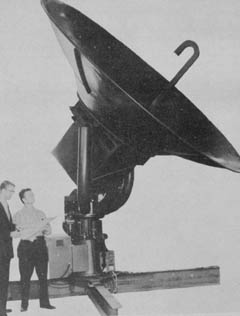Weather radar highlights of NSSL's first 40 years
...continued
Weather Radar Research

Antenna for new WSR-57 weather radars, the first of which was to be installed in Miami. In: Weather Bureau Topics, February 1959, p. 27.
The very foundation of today's NSSL lies in weather radar research and development that began before the lab's origin in 1964. Two years earlier, the National Severe Storms Project had established its Weather Radar Laboratory in Norman, Okla. This facility became a major component of the new NSSL. Part of NSSL's initial role was to maximize the use of the original WSR-57 surveillance radars for the U.S. Weather Bureau (now the NOAA National Weather Service).
WSR-57
For the first few years, NSSL collected data on Oklahoma spring storms using the WSR-57. The WSR-57 weather radar worked by sending out short bursts of energy in a beam that came from a slowly rotating antenna. When the beam hit particles the size of rain, snow or hail some of the energy was reflected back to the antenna. If the particle was large, more energy bounced back. NSSL engineers made it possible to see the strength of the returned energy by creating a contoured black and white display. The Weather Bureau and most other radar users quickly adopted this technology because it provided more detailed information about storm strength.